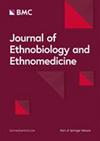Knowledge and practices of traditional management of child malnutrition and associated pathologies in Benin
IF 2.9
2区 医学
Q1 BIODIVERSITY CONSERVATION
引用次数: 0
Abstract
Child malnutrition is a major public health challenge, affecting millions of children worldwide, with alarming proportions of children under five in Benin. The complexity of managing this condition is increased by its potential association with opportunistic pathologies. An interesting approach arises from the use of medicinal plants, to address child malnutrition and its associated pathologies. This study aimed to document the knowledge and practices of Beninese mothers and traditional practitioners with regard to the use of medicinal plants to treat child malnutrition and associated diseases. A total of 844 Beninese mothers and 201 traditional healers were surveyed between March 2022 and August 2023 in the communes of Karimama, Bopa and Za-Kpota in Benin. The respondents’ knowledge of child malnutrition and associated pathologies was explored. The ethnobotanical data collected from the subjects concerned the medicinal recipes used to treat child malnutrition, the medicinal plants that make them up and the methods of use. These data were analyzed using ethnobotanical indices such as the Informant Consensus Factor, the frequency of citation of medicinal recipes types and medicinal plants, and the contribution of plants to medicinal recipes. All respondents cited a total of 82 plant species used to treat child malnutrition and associated diseases. These plants were grouped into 37 botanical families, the most common of which were Fabaceae, Malvaceae and Annonaceae. The leaves were the most commonly used part of the plant species identified. The mothers shared 122 medicinal recipes, ranging from recipes based on a single plant to more complex compositions involving five plants. The most notable plants were Moringa oleifera Lam, Phyllanthus amarus Schumach & Thonn, Senna siamea (Lam.) H.S.Irwin & Barneby, Carica papaya L. and Ocimum gratissimum L. Traditional healers provided 52 plants in 71 recipes, with Moringa oleifera featuring prominently in both single-plant and multiplant formulations. This study made it possible to constitute a rich base of medicinal recipes used against malnutrition and associated pathologies, with the preponderant involvement of certain plant species. It is therefore necessary to deepen research on these different identified species in order to scientifically assess their potential.贝宁儿童营养不良及相关病症的传统管理知识与实践
儿童营养不良是一项重大的公共卫生挑战,影响着全球数百万儿童,贝宁五岁以下儿童营养不良的比例令人担忧。由于这种情况可能与机会性疾病有关,因此增加了管理的复杂性。利用药用植物解决儿童营养不良及其相关病症是一种有趣的方法。本研究旨在记录贝宁母亲和传统医师使用药用植物治疗儿童营养不良及相关疾病的知识和实践。2022 年 3 月至 2023 年 8 月期间,在贝宁卡里马马、博帕和扎-克波塔镇对 844 名贝宁母亲和 201 名传统医师进行了调查。调查探究了受访者对儿童营养不良及相关病症的认识。从受访者那里收集到的民族植物学数据涉及治疗儿童营养不良的药方、组成药方的药用植物以及使用方法。对这些数据的分析采用了民族植物学指数,如信息提供者共识因子、药用配方类型和药用植物的引用频率以及植物对药用配方的贡献。所有受访者共列举了 82 种用于治疗儿童营养不良及相关疾病的植物。这些植物分为 37 个植物科,其中最常见的是豆科、锦葵科和葵科。在已确认的植物种类中,叶子是最常用的部分。母亲们分享了 122 种药用配方,其中既有基于一种植物的配方,也有涉及五种植物的复杂配方。最值得注意的植物有油辣木(Moringa oleifera Lam)、白千层(Phyllanthus amarus Schumach & Thonn)、番泻叶(Senna siamea (Lam.)H.S.Irwin & Barneby)、木瓜(Carica papaya L.)和洋金花(Ocimum gratissimum L.)。传统治疗师在 71 个配方中提供了 52 种植物,其中油辣木在单植物和多植物配方中都占有突出地位。这项研究使我们有可能建立一个丰富的药用配方库,用于治疗营养不良和相关病症,其中某些植物物种的参与占主导地位。因此,有必要深化对这些已确定的不同物种的研究,以便对其潜力进行科学评估。
本文章由计算机程序翻译,如有差异,请以英文原文为准。
求助全文
约1分钟内获得全文
求助全文
来源期刊

Journal of Ethnobiology and Ethnomedicine
PHARMACOLOGY & PHARMACY-
CiteScore
7.30
自引率
16.70%
发文量
66
审稿时长
>12 weeks
期刊介绍:
Journal of Ethnobiology and Ethnomedicine publishes original research focusing on cultural perceptions of nature and of human and animal health. Journal of Ethnobiology and Ethnomedicine invites research articles, reviews and commentaries concerning the investigations of the inextricable links between human societies and nature, food, and health. Specifically, the journal covers the following topics: ethnobotany, ethnomycology, ethnozoology, ethnoecology (including ethnopedology), ethnogastronomy, ethnomedicine, ethnoveterinary, as well as all related areas in environmental, nutritional, and medical anthropology.
Research focusing on the implications that the inclusion of humanistic, cultural, and social dimensions have in understanding the biological word is also welcome, as well as its potential projections in public health-centred, nutritional, and environmental policies.
 求助内容:
求助内容: 应助结果提醒方式:
应助结果提醒方式:


